Diagnosis
EEG brain activity
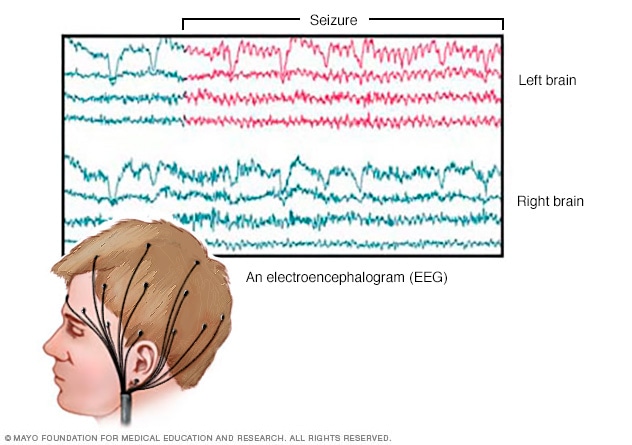
EEG brain activity
An EEG records the electrical activity of the brain via electrodes affixed to the scalp. EEG results show changes in brain activity that may be useful in diagnosing brain conditions, especially epilepsy and other conditions that cause seizures.
High-density EEG
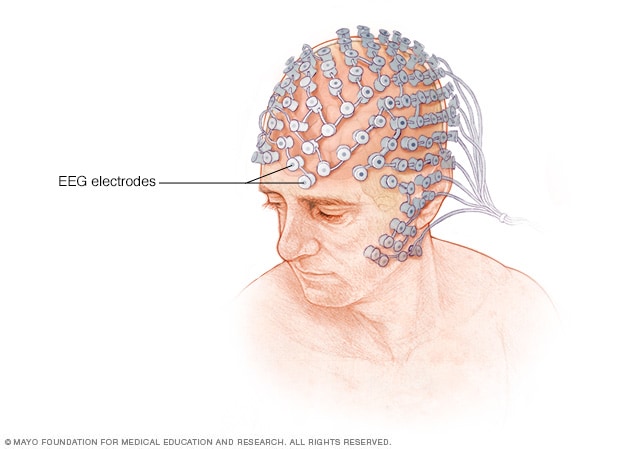
High-density EEG
During a high-density EEG test, electrodes are placed on your scalp closely spaced together. Like conventional EEG, high-density EEG records brain activity. A high-density EEG test can help your health care provider locate the area in your brain where seizures occur.
CT scan
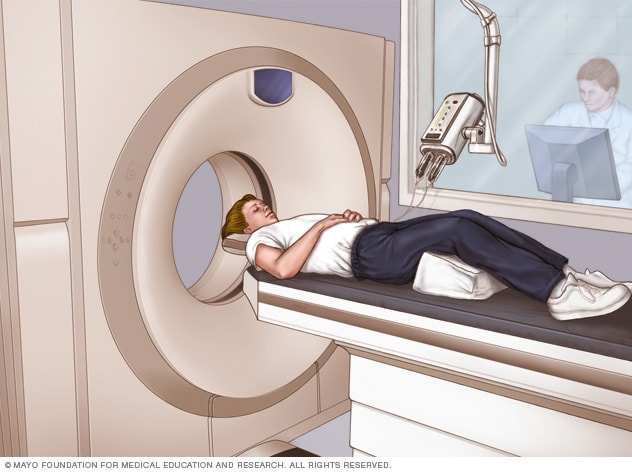
CT scan
A CT scan can be used to visualize nearly all parts of the body. It is used to diagnose disease or injury as well as to plan medical, surgical or radiation treatment.
Pinpointing seizure location
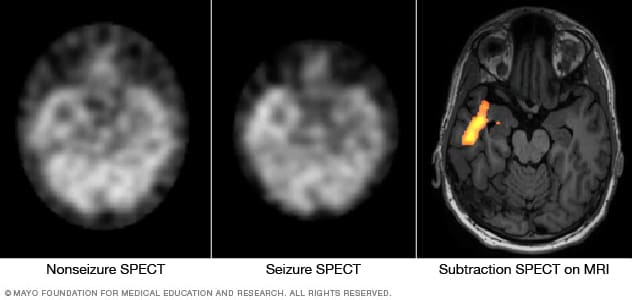
Pinpointing seizure location
These SPECT images show the blood flow in the brain of a person when there's no seizure activity (left) and during a seizure (middle). The subtraction SPECT coregistered to MRI (right) helps pinpoint the area of seizure activity by overlapping the SPECT results with brain MRI results.
After a seizure, your health care provider typically reviews your symptoms and medical history. Your provider may order several tests to determine the cause of your seizure. This helps evaluate how likely it is that you'll have another seizure.
Tests may include:
- Neurological exam. Your health care provider may test your behavior, motor abilities and mental function. This can let your provider know about the health of your brain and nervous system.
- Blood tests. Your provider may take a blood sample. The test can check for signs of infections, genetic conditions, blood sugar levels or electrolyte imbalances.
- Electroencephalogram (EEG). Flat metal discs called electrodes attached to your scalp record the electrical activity of your brain. This shows up as wavy lines on an EEG recording. The EEG may reveal a pattern that tells health care providers whether a seizure is likely to happen again. An EEG also can help rule out other conditions that look like epilepsy.
- Computerized tomography (CT) scan. A CT scan uses X-rays to obtain cross-sectional images of your brain. CT scans can reveal what may be causing your seizures. The scans can uncover tumors, bleeding and cysts.
- Magnetic resonance imaging (MRI). An MRI uses powerful magnets and radio waves to create a detailed view of your brain. Your health care provider may be able to detect what could be causing seizures.
- Positron emission tomography (PET). PET scans use a small amount of low-dose radioactive material. The material is injected into a vein. This helps visualize active areas of the brain. PET scans can uncover areas of the brain where the seizure began.
- Single-photon emission computerized tomography (SPECT). A SPECT test uses a small amount of low-dose radioactive tracer. The tracer is injected into a vein to create a detailed, 3D map of the blood flow in the brain during a seizure. A form of a SPECT test called subtraction ictal SPECT coregistered to magnetic resonance imaging (SISCOM) may provide even more-detailed results.
Treatment
Not everyone who has one seizure has another one. A seizure can be an isolated incident. Your health care provider may decide not to start treatment until you've had more than one.
The optimal goal in seizure treatment is to find the best possible therapy to stop seizures with the fewest side effects.
Medications
Many medicines are available to treat temporal lobe seizures. However, many people don't achieve seizure control with medicines alone. Side effects also are common. They can include fatigue, weight gain and dizziness.
Discuss possible side effects with your health care provider when considering treatment options. Also ask what effect your seizure medicines may have on other medicines you take. Some anti-seizure medicines can make oral contraceptives less effective, for example.
Surgical or other procedures
Vagus nerve stimulation
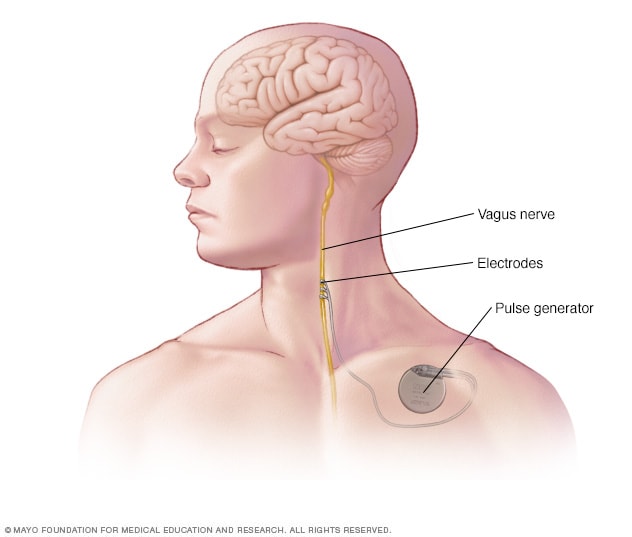
Vagus nerve stimulation
In vagus nerve stimulation, an implanted pulse generator and lead wire stimulate the vagus nerve, which leads to stabilization of irregular electrical activity in the brain.
Deep brain stimulation
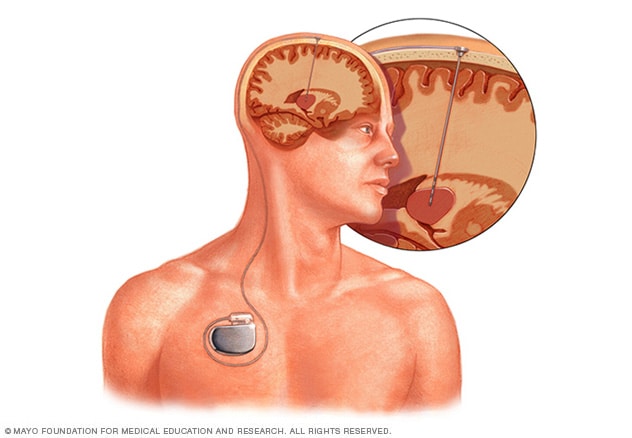
Deep brain stimulation
Deep brain stimulation involves implanting an electrode deep within the brain. The amount of stimulation delivered by the electrode is controlled by a pacemaker-like device placed under the skin in the chest. A wire that travels under the skin connects the device to the electrode.
When anti-seizure medicines aren't effective, other treatments may be an option:
-
Surgery. The goal of surgery is to stop seizures from happening. This is often done through a traditional surgery, where surgeons operate to remove the area of the brain where seizures begin. In certain people, surgeons may be able to use MRI-guided laser therapy as a less invasive way to destroy the area of damaged tissue that causes seizures.
Surgery works best for people who have seizures that always originate in the same place in their brains. Surgery generally isn't an option if your seizures come from more than one area of the brain. Surgery also may not be an option if the focus of your seizure can't be identified. This also may be true if your seizures come from a part of the brain that performs vital functions.
- Vagus nerve stimulation. A device implanted underneath the skin of your chest stimulates the vagus nerve in your neck. This sends signals to your brain that inhibit seizures. With vagus nerve stimulation, you may still need to take medicine. But you may be able to lower the dose.
- Responsive neurostimulation. During responsive neurostimulation, a device implanted on the surface of your brain or within brain tissue can detect seizure activity. The device then delivers an electrical stimulation to the area to stop the seizure.
- Deep brain stimulation. For this therapy, a surgeon implants electrodes within certain areas of the brain. The electrodes produce electrical impulses that regulate brain activity to stop seizures. The electrodes attach to a pacemaker-like device placed under the skin of your chest. This device controls the amount of stimulation produced.
- Dietary therapy. A ketogenic diet can improve seizure control. The diet is high in fat and low in carbohydrates. It can be hard to follow because the diet is restrictive. Variations on a ketogenic diet also may provide some benefit but are less effective. They include the low glycemic index and modified Atkins diets.
Pregnancy and seizures
Women who've had previous seizures typically are able to have healthy pregnancies. But it's important to know that certain medicines can lead to birth defects.
In particular, valproic acid has been associated with cognitive deficits and neural tube defects, such as spina bifida. Valproic acid is one possible medicine for generalized seizures. The American Academy of Neurology recommends that women don't use valproic acid during pregnancy because of risks to the baby.
Discuss these risks with your health care provider. In addition to the risk of birth defects, pregnancy can alter medicine levels. If you've had seizures, it's important to talk to a health care provider about your medicines before you become pregnant.
In some cases, it may be appropriate to change the dose of seizure medicine you take before or during pregnancy. Medicines also may be switched during pregnancy.
Contraception and anti-seizure medicines
It also is important to know that some anti-seizure medicines can alter the effectiveness of oral contraceptives, which are forms of birth control. And some oral contraceptives can speed up the absorption of seizure medicines. Check with your health care provider to evaluate whether your medicine interacts with your oral contraceptive. Ask if other forms of contraception need to be considered.
You see, an epileptic seizure is an abnormal electrical disturbance of the brain. The device is implanted under the skin, and four electrodes are attached to the outer layers of your brain. The device monitors brain waves, and when it senses abnormal electrical activity it fires electrical stimulation and stops the seizures.
Lifestyle and home remedies
Here are some steps you can take to help with seizure control:
- Take medicine correctly. Don't adjust the dosage before talking to your health care provider. If you feel your medicine needs to be changed, discuss it with your provider.
- Get enough sleep. Lack of sleep can trigger seizures. Be sure to get adequate rest every night.
- Wear a medical alert bracelet. This helps emergency personnel know how to treat you correctly if you have another seizure.
- Ask your health care provider about driving restrictions. Someone with a seizure disorder has to be seizure-free for a certain length of time before being able to drive. The amount of time varies by state.
Personal safety
Seizures don't usually result in serious injury. But injury is possible if you have recurrent seizures. These steps can help you avoid injury during a seizure:
- Take care near water. Don't swim alone or ride in a boat without someone nearby.
- Wear a helmet for protection during activities such as bike riding or sports participation.
- Take showers instead of baths unless someone is near you.
- Modify your furnishings. Pad sharp corners, buy furniture with rounded edges and choose chairs that have arms to keep you from falling off the chair. Consider carpet with thick padding to protect you if you fall.
- Display seizure first-aid tips in a place where people can easily see them. Include any important phone numbers.
Seizure first aid
It's helpful to know what to do if you witness someone having a seizure. If you're at risk of having seizures in the future, pass this information along to family, friends and co-workers.
To help someone during a seizure:
- Carefully roll the person onto one side.
- Place something soft under the person's head.
- Loosen tight neckwear.
- Don't put your fingers or other objects in the person's mouth.
- Don't try to restrain someone having a seizure.
- Clear away dangerous objects, if the person is moving.
- Stay with the person until medical personnel arrive.
- Observe the person closely so that you can provide details on what happened.
- Time the seizure.
- Stay calm.
Coping and support
Even after they're under control, seizures can affect your life. Temporal lobe seizures may present even more of a coping challenge. This is because people may not recognize some of its symptoms as a seizure. Children may get teased or be embarrassed by their condition. And living with the constant threat of another seizure may frustrate children and adults.
At home
Your family can provide much-needed support. Tell them what you know about your seizure disorder. Let them know they can ask you questions, and be open to conversations about their worries. Help them understand your condition by sharing any educational materials or other resources that your health care provider has given you.
At work
Meet with your supervisor and talk about your seizure disorder and how it affects you. Discuss what you need from your supervisor or co-workers if a seizure happens while at work. Consider talking with your co-workers about seizure disorders. You can widen your support system and bring about acceptance and understanding.
You're not alone
Remember, you don't have to go it alone. Reach out to family and friends. Ask your health care provider about local support groups or join an online support community. Don't be afraid to ask for help. Having a strong support system is important to living with any medical condition.
Preparing for your appointment
In some cases, seizures need immediate medical attention, and there's not always time to prepare for an appointment.
In other cases, your first appointment to evaluate a seizure may be with your primary care provider. Or you may be referred to a specialist, such as a doctor trained in brain and nervous system conditions, known as a neurologist. You also might be referred to a neurologist trained in epilepsy, known as an epileptologist.
To prepare for your appointment, consider what you can do to get ready and understand what to expect from your health care provider.
What you can do
- Record information about the seizure. Include the time, location, symptoms you experienced and how long it lasted, if you know these details. Seek input from anyone who may have seen the seizure, such as a family member, friend or co-worker, so that you can record information you may not know.
- Be aware of any pre-appointment restrictions. At the time you make the appointment, ask if there's anything you need to do in advance to be ready for any medical tests or exams.
- Write down key personal information, including any major stresses or recent life changes.
- Make a list of all medicines, vitamins or supplements that you're taking, including dosages.
- Take a family member or friend along, to help you remember all the information provided during an appointment. Also, because you may not be aware of everything that happens when you're having a seizure, your health care provider may want to ask questions of someone who was a witness.
- Write down questions to ask your health care provider. Preparing a list of questions helps you make the most of your time with your provider.
For seizures, some basic questions to ask your health care provider include:
- What do you think caused my seizure?
- Do I need to have any tests done?
- What treatment approach do you recommend?
- What are the alternatives to the primary approach that you're suggesting?
- How likely is it that I might have another seizure?
- How can I make sure that I don't hurt myself if I have another seizure?
- I have these other health conditions. How can I best manage them together?
- Are there any restrictions that I need to follow?
- Should I see a specialist? What will that cost, and will my insurance cover it?
- Is there a generic alternative to the medicine you're prescribing?
- Are there any brochures or other printed material that I can take home with me? What websites do you recommend?
In addition to the questions that you've prepared to ask your health care provider, don't hesitate to ask questions during your appointment at any time that you don't understand something.
What to expect from your doctor
Your health care provider is likely to ask you a number of questions:
- Can you describe your seizure episode?
- Where were you and what happened right before it started?
- Was anyone there to witness what happened?
- What do you remember feeling just before the seizure? What about right after the seizure?
- What symptoms did you experience?
- How long did the seizure last?
- Have you ever had a seizure or other neurological problem in the past?
- Do you have any family members who have been diagnosed with a seizure disorder or epilepsy?
- Have you recently traveled outside the country?